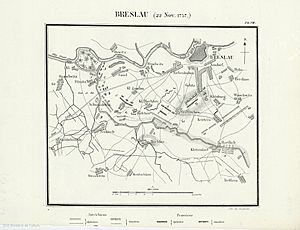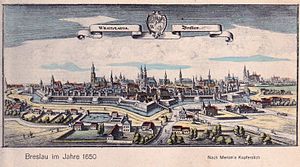Siege of Breslau (1757) facts for kids
Quick facts for kids Siege of Breslau |
|||||||
|---|---|---|---|---|---|---|---|
| Part of the Third Silesian War (Seven Years' War) | |||||||
 |
|||||||
|
|||||||
| Belligerents | |||||||
|
|
|||||||
| Commanders and leaders | |||||||
| Frederick the Great | Soloman Sprecher von Bernegg | ||||||
| Strength | |||||||
| 36,000 167 guns |
17,000 | ||||||
| Casualties and losses | |||||||
| minimal | 17,000 captured, including: 31 generals, over 700 officers, 1,000 horses, all supplies |
||||||
The Siege of Breslau was an important battle during the Third Silesian War, which was part of the bigger Seven Years' War. It happened in December 1757 in a city called Breslau (now Wrocław, Poland).
After losing the Battle of Leuthen, the Austrian army moved into Breslau. About 17,000 Austrian and French soldiers defended the city. They were led by Lieutenant General Field Marshal Soloman Sprecher von Bernegg. Outside the city, a larger Prussian army, led by Frederick the Great, prepared to attack. The siege lasted from December 7 to December 19, 1757.
What Led to the Siege?
- Further information: Third Silesian War
After taking over Saxony, King Frederick of Prussia fought in Bohemia. When French forces attacked Hanover, an ally of Prussia, Frederick moved his army west. On November 5, 1757, he won a big victory against French and Austrian forces at the Battle of Rossbach.
Meanwhile, the Austrians had taken back Silesia. Prince Charles had captured the city of Schweidnitz and moved into lower Silesia. Frederick learned that Breslau had fallen to the Austrians on November 22.
Frederick and his soldiers marched about 274 kilometers (170 miles) in just 12 days. They met up with other Prussian troops who had survived fighting in Breslau. This combined army of about 33,000 soldiers arrived near Leuthen, about 27 kilometers (17 miles) west of Breslau. There, they found 65,000 Austrian soldiers.
At the Battle of Leuthen, the Prussians used a clever move to attack the weakest part of the Austrian line. This battle was a huge victory for Prussia. The Austrians retreated into Bohemia, leaving Silesia to the Prussians again.
Prince Charles and his second-in-command, Count Leopold Joseph von Daun, were very upset by this loss. Frederick sent some of his cavalry to chase Charles's retreating army towards Königgratz. Frederick then took most of his army to Breslau.
The Austrians really wanted to hold onto Breslau. Losing it would mean losing control of Silesia and a lot of pride. The city also held huge amounts of supplies. By chasing Charles's army into Bohemia, the Prussians made sure the Austrian soldiers in Breslau were all alone. The Austrian commander knew his situation was bad. He put up signs around the city, warning that anyone who talked about giving up would be hanged right away.
The City's Defenders
The commander of the Imperial forces inside Breslau was Soloman Sprecher von Bernegg. He was 57 years old and a very experienced soldier. He had served in the military since he was a teenager.
Sprecher led a mixed group of soldiers from different places. These included troops from France, Baden-Baden, Wuerttemberg, Bavaria, some hired soldiers from the Netherlands, and regiments from the Military Frontier.
The Siege Begins
The weather was extremely cold, with both rain and snow. Both the attackers and the defenders suffered greatly. By December 7, the Prussians had cut off Breslau from all outside communication. They began building their artillery positions.
In the following days, the Prussians took control of the moats, dug trenches, and set up more cannons. As soon as a cannon was ready, they started firing. By December 12, Prussian troops, led by Prince Ferdinand, controlled the St. Moritz church in the city's suburbs. They set up a new cannon position there with two cannons and two mortars.
The Prussians attacked the city walls again and again. The obstacles made of sharpened stakes (called abatis) and the trenches were almost frozen solid. On December 14, one of Breslau's storage buildings caught fire during heavy shelling. The building exploded, destroying several houses. While the Austrians were trying to put out the fire, the Prussians built more cannon positions south of the city.
The weather got even worse, and the Prussian siege lines moved closer to the walls. Soldiers called sappers began digging tunnels under the city's defenses.
On the night of December 13–14, General Wied zu Neuwied and his Prussian force took the Polnischen Vorstadt, a part of the city next to the Oder river. They captured 51 Pandur soldiers. On the 14th, the monks from St. Moritz church fled into the city. By 3:00 PM that afternoon, all communication between the city and the outside world was cut off. The Prussians had taken over the last outposts outside the walls.
That night, the Prussians fixed their largest cannon position and started firing on the city again. Within hours, they hit a second storage building. This explosion destroyed part of the city's defenses and killed or wounded about 800 defenders. The attack continued, day and night, for the next three days.
On the night of December 15–16, the Prussians extended their trenches to 1,000 steps. They also began building a new attacking point. The next day, they started digging tunnels (sapping) under the defenses. Sprecher also reported that the Prussians used a special type of firing called ricochet. This meant firing cannonballs at a low angle so they would just clear the wall and then bounce before exploding. These shots destroyed several gun positions and damaged parts of the wall.
Finally, on December 19, Sprecher saw no hope of help from either Daun or Prince Charles. He decided to surrender the city to the Prussians. By December 20, the Prussians controlled all the city gates. The next day, the Austrian and French soldiers marched out through the Schweidnitz gate.
What Happened Next
The Austrians and French lost 17,000 soldiers. This was the entire group defending the city. They also lost all the supplies in Breslau, over 1,000 horses, 81 cannons, and almost 700 officers, including 13 generals. About 1,200 of the defending soldiers were killed. The officers and soldiers were allowed to keep their personal belongings, but all other supplies and materials were given to the Prussians.
The Prussians gained huge amounts of supplies. They also got 1,024 horses and 220 wagons. The Prussians took back 37 cannons that had been captured from them earlier that year. They also captured another 44 Austrian cannons. In addition, many Prussian officers who had been held prisoner in Breslau were set free.
Here are some of the supplies the Prussians captured:
| 60,100 bushels of rye |
| 1,445 bushels of wheat |
| 24,606 bushels of meal |
| 6,670 bushels of barley |
| 18,663 bushels of hay |
| 1,500 bales of straw |
| 144,000 florins (money) |
Losing Breslau meant that Austria had truly lost control of the rich area of Silesia. The terrible month of December, with the huge loss at Leuthen, Prince Charles's fast retreat, and then losing the soldiers in Breslau, wiped out all of Austria's gains from the summer.
Maria Theresa, the ruler of Austria, did not give up hope of winning the war against Frederick. She still wanted to get back Silesia, which she had lost in 1748. However, she removed her brother-in-law Charles from leading the army. She sent him to the Netherlands, where he was better suited as a governor. She then put Count Leopold Joseph von Daun in charge of her army in Bohemia.


